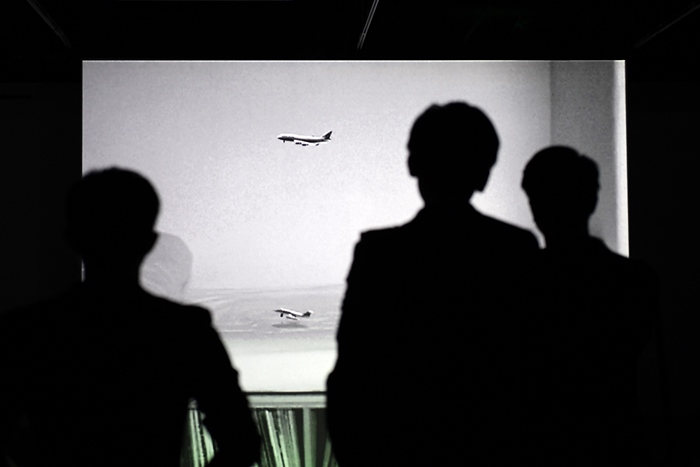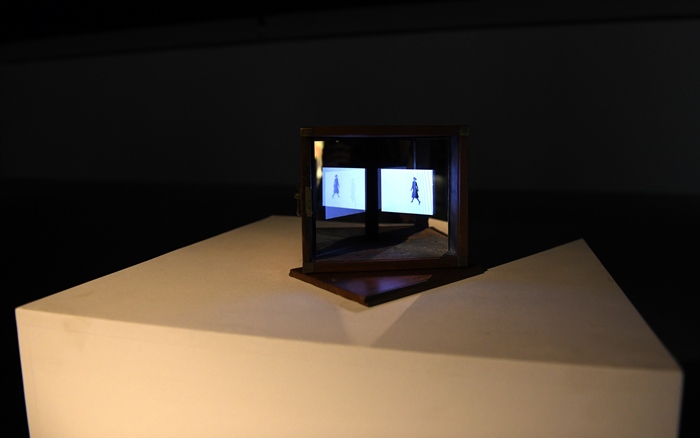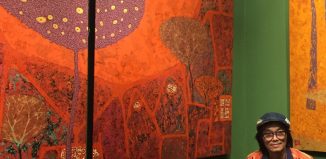About Hiraki Sawa’s “Fragments” Exhibition at VCCA: A Satisfying Experience
Written by Namnggg and Uyen for Hanoi Grapevine
Photos by VCCA

Copyrights by VCCA and Hanoi Grapevine
Prior to diving into “Fragments”, the name Hiraki Sawa popped up in good lighting as an artist whose “videos explore psychological landscapes, unexpected worlds and the interweaving of domestic and imaginary spaces”*. His technically demanding works would be on display at VCCA, a newly emerged space on the Hanoi art map, raised a certain level of curiosity and eyebrows both in terms of quality and practicality. To our pleasant surprise, the exhibition was an enjoyable experience.
The first impression of the exhibition is how well-thought out the placement of each installation is. Starting at the entrance with two single channel videos, “Sleeping machine” I and II feel like the mirror in the movie “Alice though the looking glass”. They “sing” the lullaby with images of sheeps running through empties houses, the clocks ticking while the their wheel turning without any orders. A portal lures us into a dreamy world of the artist’s memories. From there, you may start to explore the “fragmented” worlds of memories and time. The triple-channels-video, projecting toy rocking horses running around an old English apartment, on three large scale screen (Going places sitting down, 2006), or tiny screens, carefully covered in old wooden toy boxes, standing alone on white tables, as if they were the lost/falling out parts of remembrances.
Imaging being in a Hypnagogia – a borderland state, you wonder around without consciousness, through unphysical times and places mixing together. Then suddenly, there are tiny old family pictures to his first reminiscences in London, white ink on unique inkjet print, show his extraordinary art of processing the pasts, memories and emotions. They occupy completely the second part of the exhibition and ousts every other works. They leave us an odd feeling, but also a small break from the different works before and let us time for self-reflection, to find the bridge links to our own memories. After that, viewers are again overwhelmed by his large scale projections. Different art works were made within three years, inspired by the time Hiraki moved from his hometown Kanazawa, Japan to London. They tell the colliding story of two different cultures, the migration, the transfer from this place to another.
Finally, viewers have to confront with “Lineament”, a two channels-video, made out of two large scale projections and a turntable. The light in the exhibition hall was minimized, not only not to disturbed the art works, which mostly are screens and projections, but also somehow, together with the flares from the screens, created some sort of twilight effects, nighty path through the hallway. It truly feels like the viewers were sleep-walking. Some people might think there is too little artworks for such a big exhibition room, unlike some exhibitions where a numerous amount of works a packed in. But exhibited artworks are never put random in the exhibition room. They are place separated for reasons. Each of Hiraki’s work are like huge glowing sculptures, they need spaces in order not to be mixed with other’s halos. They need spaces, to be able to completely be its own world, where viewers can be invited to dive into that world without looking at the others. At the same time, different surreal environments surrounding the viewers, created a whole new bigger world.
“Fragments” is a visual story of searching for memories, personal feelings in each stage of life. The concept of “Times” appears throughout every art works – physically as well as emotionally: its movements, manifestations are shown by odd objects moving, remembrances, and surreal environments. His interests in space and time were maybe stronger since his reintegration from Japan to London as an independent artist.
In some interviews and talks at VCCA a few weeks ago, people wondered why Sawa making videos instead of sculptures. Sawa replied, as the legendary director Tarkovsky, his practice is an art of sculpturing – Hiraki sculptures “Times” into his moving images. Even without his answer, viewers were still able to find the sculpturing from each artworks. Those large scale projection screens, weren’t made from normal canvas, they were, itself sculptures: gypsum walls or the tiny screens in old wooden boxes. Moreover, through controlling times and spaces or create constellations in his films, he transferred successfully his intentions and feelings to the viewers. Regarding this aspect, “Fragments” could be considered as an well-put-together exhibition.



Some personal annotations on Hiraki’s artworks
“Lineament” (2012) is a two-channel video installation, which was inspired from a close friend of Hiraki, who suffered from amnesia. The video is projected on two separate screens, facing each other, create a almost 90 degree corner. The palindromic audio, performed by Dale Berning and Ute Kanngieser, played with a turntable standing as an installation in the room, forward then backwards.
It shows life of a male protagonist, struggling with memory lost in his apartment. He wakes up, tries to figure out the usage of everyday life’s items. His memories were recalled, brought back together but then somehow “deleted” in a abnormal way.
The LP record, appears together as he’s awake, changes its normal usages and structures: A turntable on a mirrored plinth on a beach, the tide coming in to flood its base. Each groove now uncoil from the LP into black thin strings, going through the man’s head, finding the way out: ear to ear, through the walls, door gaps, or just disappear by moving out of the screen. It’s how the memories leaving him. As a part of the Installation, the vinyl will be play over and over again, in each exhibition, until it wears out and full of scratches. The Vinyl, as a symbol of the memories and the love of music for Sawa’s friend, will be, with times, disappear, like the amnesia he suffers.
Lineament leaves us so many space for interpretation, pushed us to construct something or put each scene of the film together. While the protagonist is just trying to under the objects in his room. It’s the act of playing with the viewer’s mind, when you let yourself into the film, the unrealistic of the room, the re-purposed objects make us forget the feeling of time. The only thing that left of time is the endlessness of the music, which will be one day, worn out.
“Going places sitting down” (2004) was his first large scale three-channel-video projection. Dreamy, magical things happen across the three screens: in an old, tranquil English house, without any human presence, tiny things like antique rocking horses, old planes,…crawling out of their hidden places. On a mantelpiece which, at the first glens, seems like a forest in the winter, covered in snows, there are toy rocking horses, moving slowly, gently to and from. In the bathroom, in a half filled sink, these horses sliding smoothly through the choppy waters. On another screen there are books, arranged as mainland, surrounded by the sea, miniature ships are sailing on the water while mans on camels traverse across the “mainland”… Sawa created a very much surreal but also somehow dreamy world, by using re-scaled objects, putting different elements together (sea, book piles,…) then mixed them up in ordinary domestic environments. This pretty much reminds us of our childhood- Sawa’s childhood. Remember how we played with the toy airplanes, “flying” them with our hands from this room to another. Or spending time in the bathtub, enjoy an imaginary world where ships and ducks were swimming together…
The three channels were set up as a path for the viewers to access into different rooms, since each room is itself a separate world. The whole scenery, which is beautiful yet somehow hunting, give us flashbacks of our own childhood memories. It shows how Sawa’s abilities in controlling times and playing with memories through his wonderful animations.
* Cited from James Cohen Gallery (https://www.jamescohan.com/artists/hiraki-sawa)/




















